A Report on Pilkington's Organizational Change and Development
VerifiedAdded on 2020/04/01
|11
|2479
|97
Report
AI Summary
This report examines Pilkington's organizational change process, highlighting the company's adaptation to both internal and external pressures. The analysis covers the factors that drove change, including the need to address internal inefficiencies and compete in a global market. The report details the three phases of change undertaken by Pilkington, including restructuring the organizational hierarchy, refining the organization through program changes and consultative management, and addressing employee resistance through new policies and agreements. It also explores the organizational culture problems related to employee performance and overtime, and how the company addressed these issues through a shift to a consultative management style and the use of teams. Furthermore, the report discusses employee motivation strategies, resistance to change, and how Pilkington attempted to restructure its organizational structure to improve communication and efficiency. The conclusion emphasizes the inevitability of organizational change and the importance of employee involvement in the process.
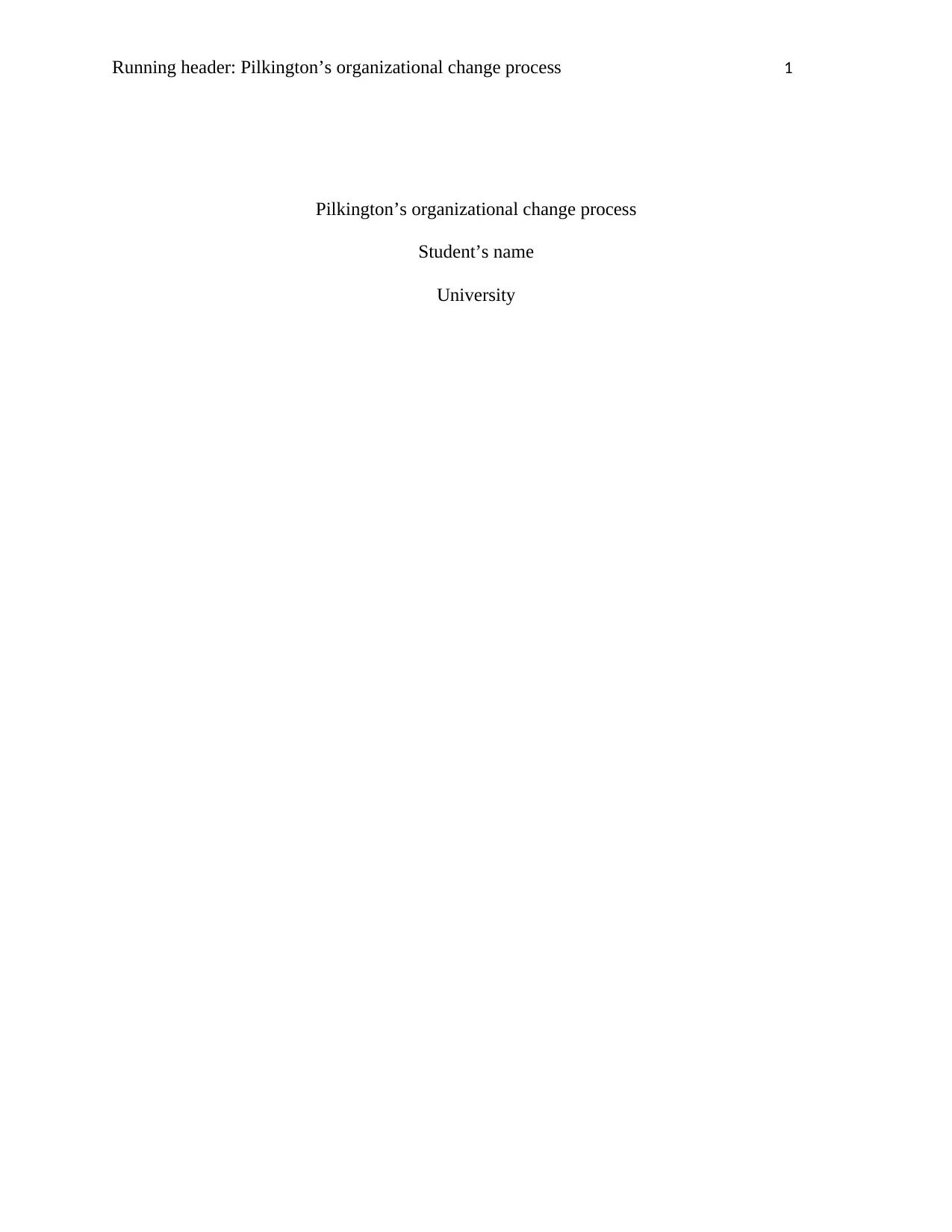
Running header: Pilkington’s organizational change process 1
Pilkington’s organizational change process
Student’s name
University
Pilkington’s organizational change process
Student’s name
University
Paraphrase This Document
Need a fresh take? Get an instant paraphrase of this document with our AI Paraphraser
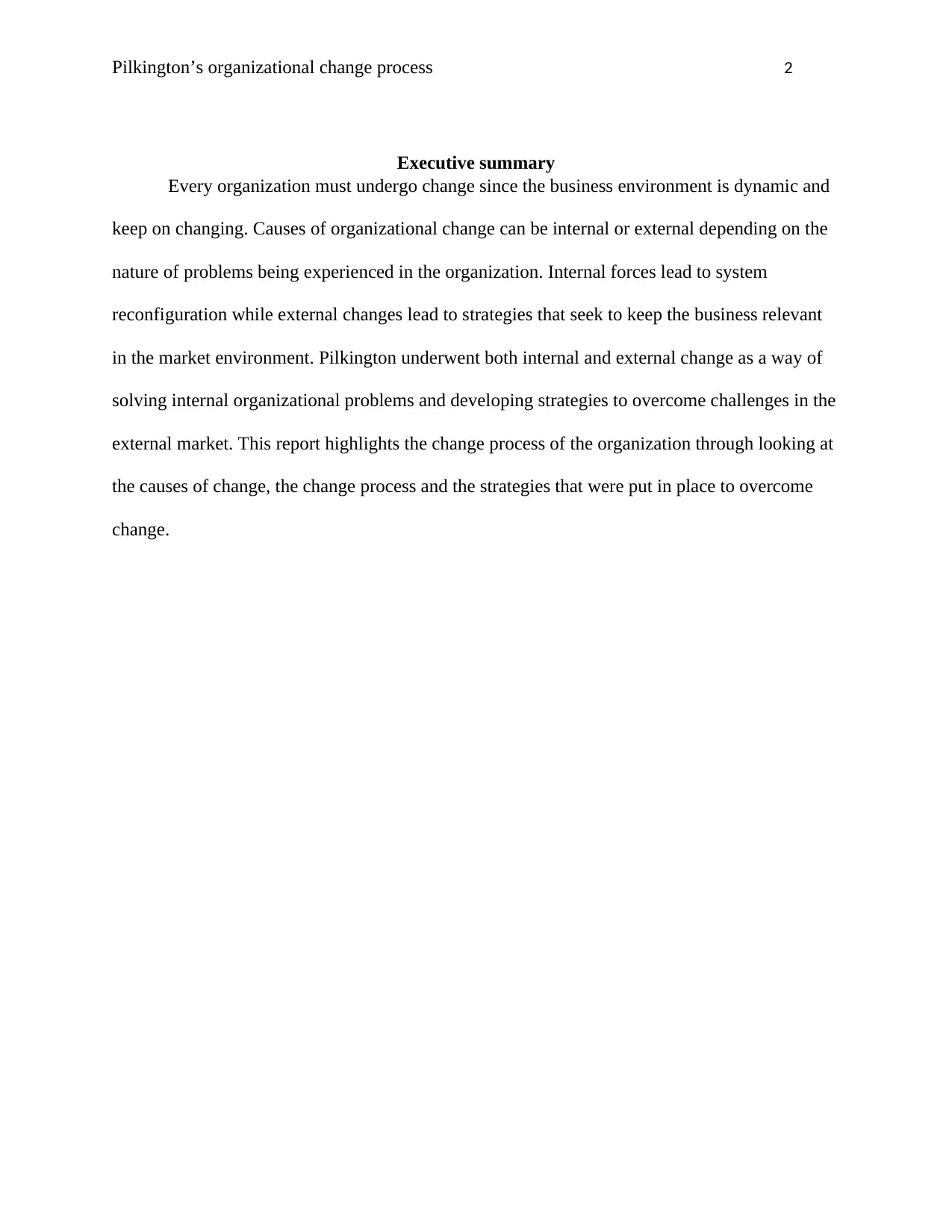
Pilkington’s organizational change process 2
Executive summary
Every organization must undergo change since the business environment is dynamic and
keep on changing. Causes of organizational change can be internal or external depending on the
nature of problems being experienced in the organization. Internal forces lead to system
reconfiguration while external changes lead to strategies that seek to keep the business relevant
in the market environment. Pilkington underwent both internal and external change as a way of
solving internal organizational problems and developing strategies to overcome challenges in the
external market. This report highlights the change process of the organization through looking at
the causes of change, the change process and the strategies that were put in place to overcome
change.
Executive summary
Every organization must undergo change since the business environment is dynamic and
keep on changing. Causes of organizational change can be internal or external depending on the
nature of problems being experienced in the organization. Internal forces lead to system
reconfiguration while external changes lead to strategies that seek to keep the business relevant
in the market environment. Pilkington underwent both internal and external change as a way of
solving internal organizational problems and developing strategies to overcome challenges in the
external market. This report highlights the change process of the organization through looking at
the causes of change, the change process and the strategies that were put in place to overcome
change.
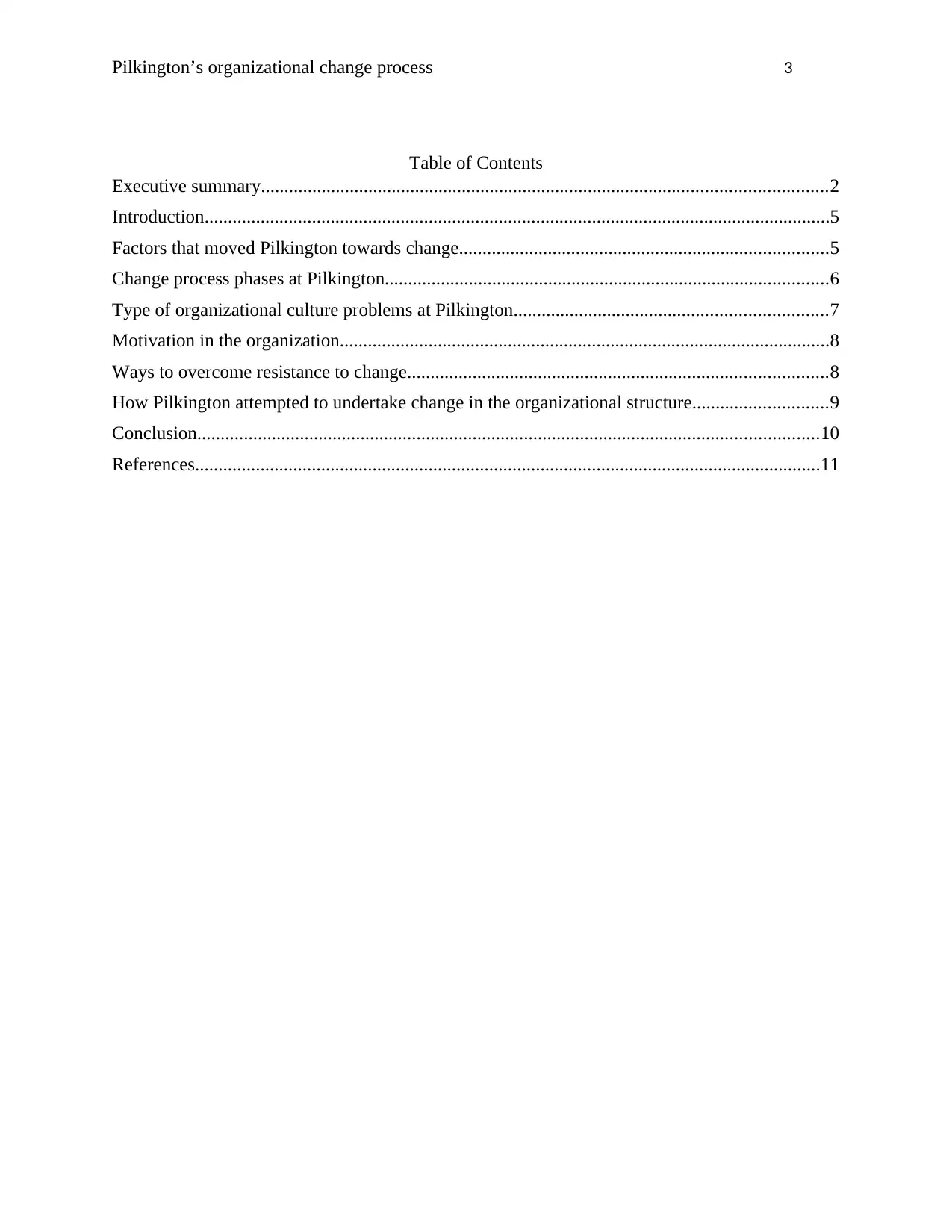
Pilkington’s organizational change process 3
Table of Contents
Executive summary.........................................................................................................................2
Introduction......................................................................................................................................5
Factors that moved Pilkington towards change...............................................................................5
Change process phases at Pilkington...............................................................................................6
Type of organizational culture problems at Pilkington...................................................................7
Motivation in the organization.........................................................................................................8
Ways to overcome resistance to change..........................................................................................8
How Pilkington attempted to undertake change in the organizational structure.............................9
Conclusion.....................................................................................................................................10
References......................................................................................................................................11
Table of Contents
Executive summary.........................................................................................................................2
Introduction......................................................................................................................................5
Factors that moved Pilkington towards change...............................................................................5
Change process phases at Pilkington...............................................................................................6
Type of organizational culture problems at Pilkington...................................................................7
Motivation in the organization.........................................................................................................8
Ways to overcome resistance to change..........................................................................................8
How Pilkington attempted to undertake change in the organizational structure.............................9
Conclusion.....................................................................................................................................10
References......................................................................................................................................11
⊘ This is a preview!⊘
Do you want full access?
Subscribe today to unlock all pages.

Trusted by 1+ million students worldwide
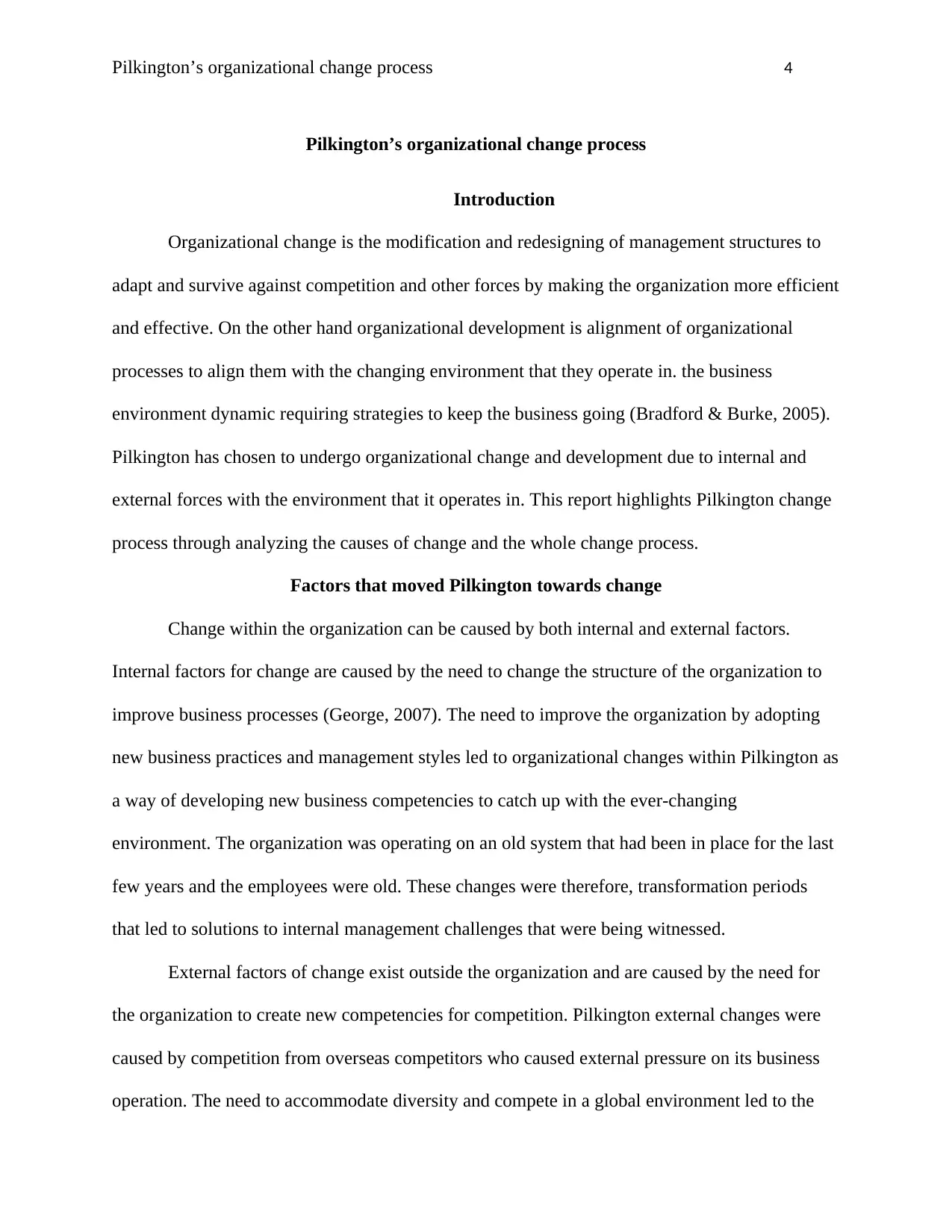
Pilkington’s organizational change process 4
Pilkington’s organizational change process
Introduction
Organizational change is the modification and redesigning of management structures to
adapt and survive against competition and other forces by making the organization more efficient
and effective. On the other hand organizational development is alignment of organizational
processes to align them with the changing environment that they operate in. the business
environment dynamic requiring strategies to keep the business going (Bradford & Burke, 2005).
Pilkington has chosen to undergo organizational change and development due to internal and
external forces with the environment that it operates in. This report highlights Pilkington change
process through analyzing the causes of change and the whole change process.
Factors that moved Pilkington towards change
Change within the organization can be caused by both internal and external factors.
Internal factors for change are caused by the need to change the structure of the organization to
improve business processes (George, 2007). The need to improve the organization by adopting
new business practices and management styles led to organizational changes within Pilkington as
a way of developing new business competencies to catch up with the ever-changing
environment. The organization was operating on an old system that had been in place for the last
few years and the employees were old. These changes were therefore, transformation periods
that led to solutions to internal management challenges that were being witnessed.
External factors of change exist outside the organization and are caused by the need for
the organization to create new competencies for competition. Pilkington external changes were
caused by competition from overseas competitors who caused external pressure on its business
operation. The need to accommodate diversity and compete in a global environment led to the
Pilkington’s organizational change process
Introduction
Organizational change is the modification and redesigning of management structures to
adapt and survive against competition and other forces by making the organization more efficient
and effective. On the other hand organizational development is alignment of organizational
processes to align them with the changing environment that they operate in. the business
environment dynamic requiring strategies to keep the business going (Bradford & Burke, 2005).
Pilkington has chosen to undergo organizational change and development due to internal and
external forces with the environment that it operates in. This report highlights Pilkington change
process through analyzing the causes of change and the whole change process.
Factors that moved Pilkington towards change
Change within the organization can be caused by both internal and external factors.
Internal factors for change are caused by the need to change the structure of the organization to
improve business processes (George, 2007). The need to improve the organization by adopting
new business practices and management styles led to organizational changes within Pilkington as
a way of developing new business competencies to catch up with the ever-changing
environment. The organization was operating on an old system that had been in place for the last
few years and the employees were old. These changes were therefore, transformation periods
that led to solutions to internal management challenges that were being witnessed.
External factors of change exist outside the organization and are caused by the need for
the organization to create new competencies for competition. Pilkington external changes were
caused by competition from overseas competitors who caused external pressure on its business
operation. The need to accommodate diversity and compete in a global environment led to the
Paraphrase This Document
Need a fresh take? Get an instant paraphrase of this document with our AI Paraphraser
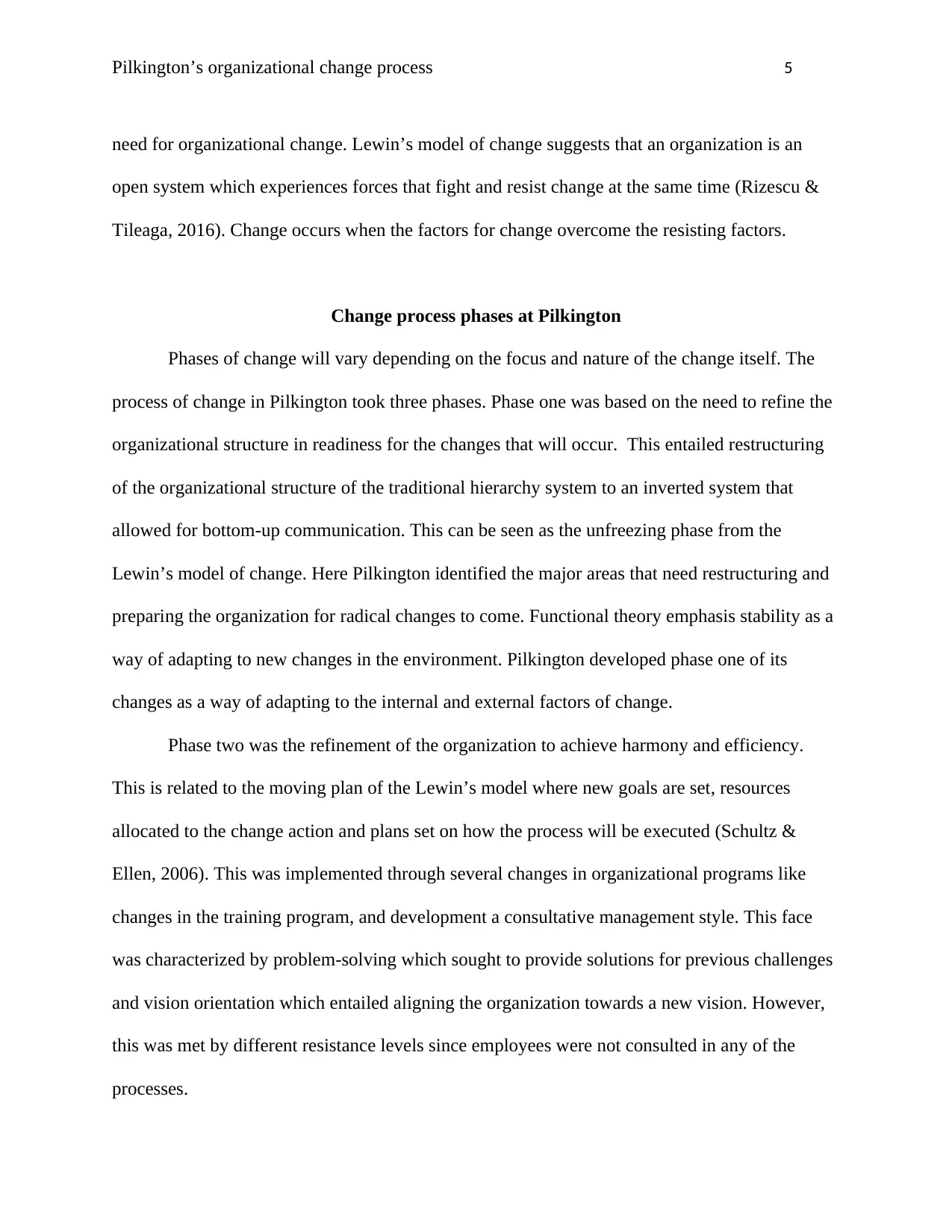
Pilkington’s organizational change process 5
need for organizational change. Lewin’s model of change suggests that an organization is an
open system which experiences forces that fight and resist change at the same time (Rizescu &
Tileaga, 2016). Change occurs when the factors for change overcome the resisting factors.
Change process phases at Pilkington
Phases of change will vary depending on the focus and nature of the change itself. The
process of change in Pilkington took three phases. Phase one was based on the need to refine the
organizational structure in readiness for the changes that will occur. This entailed restructuring
of the organizational structure of the traditional hierarchy system to an inverted system that
allowed for bottom-up communication. This can be seen as the unfreezing phase from the
Lewin’s model of change. Here Pilkington identified the major areas that need restructuring and
preparing the organization for radical changes to come. Functional theory emphasis stability as a
way of adapting to new changes in the environment. Pilkington developed phase one of its
changes as a way of adapting to the internal and external factors of change.
Phase two was the refinement of the organization to achieve harmony and efficiency.
This is related to the moving plan of the Lewin’s model where new goals are set, resources
allocated to the change action and plans set on how the process will be executed (Schultz &
Ellen, 2006). This was implemented through several changes in organizational programs like
changes in the training program, and development a consultative management style. This face
was characterized by problem-solving which sought to provide solutions for previous challenges
and vision orientation which entailed aligning the organization towards a new vision. However,
this was met by different resistance levels since employees were not consulted in any of the
processes.
need for organizational change. Lewin’s model of change suggests that an organization is an
open system which experiences forces that fight and resist change at the same time (Rizescu &
Tileaga, 2016). Change occurs when the factors for change overcome the resisting factors.
Change process phases at Pilkington
Phases of change will vary depending on the focus and nature of the change itself. The
process of change in Pilkington took three phases. Phase one was based on the need to refine the
organizational structure in readiness for the changes that will occur. This entailed restructuring
of the organizational structure of the traditional hierarchy system to an inverted system that
allowed for bottom-up communication. This can be seen as the unfreezing phase from the
Lewin’s model of change. Here Pilkington identified the major areas that need restructuring and
preparing the organization for radical changes to come. Functional theory emphasis stability as a
way of adapting to new changes in the environment. Pilkington developed phase one of its
changes as a way of adapting to the internal and external factors of change.
Phase two was the refinement of the organization to achieve harmony and efficiency.
This is related to the moving plan of the Lewin’s model where new goals are set, resources
allocated to the change action and plans set on how the process will be executed (Schultz &
Ellen, 2006). This was implemented through several changes in organizational programs like
changes in the training program, and development a consultative management style. This face
was characterized by problem-solving which sought to provide solutions for previous challenges
and vision orientation which entailed aligning the organization towards a new vision. However,
this was met by different resistance levels since employees were not consulted in any of the
processes.
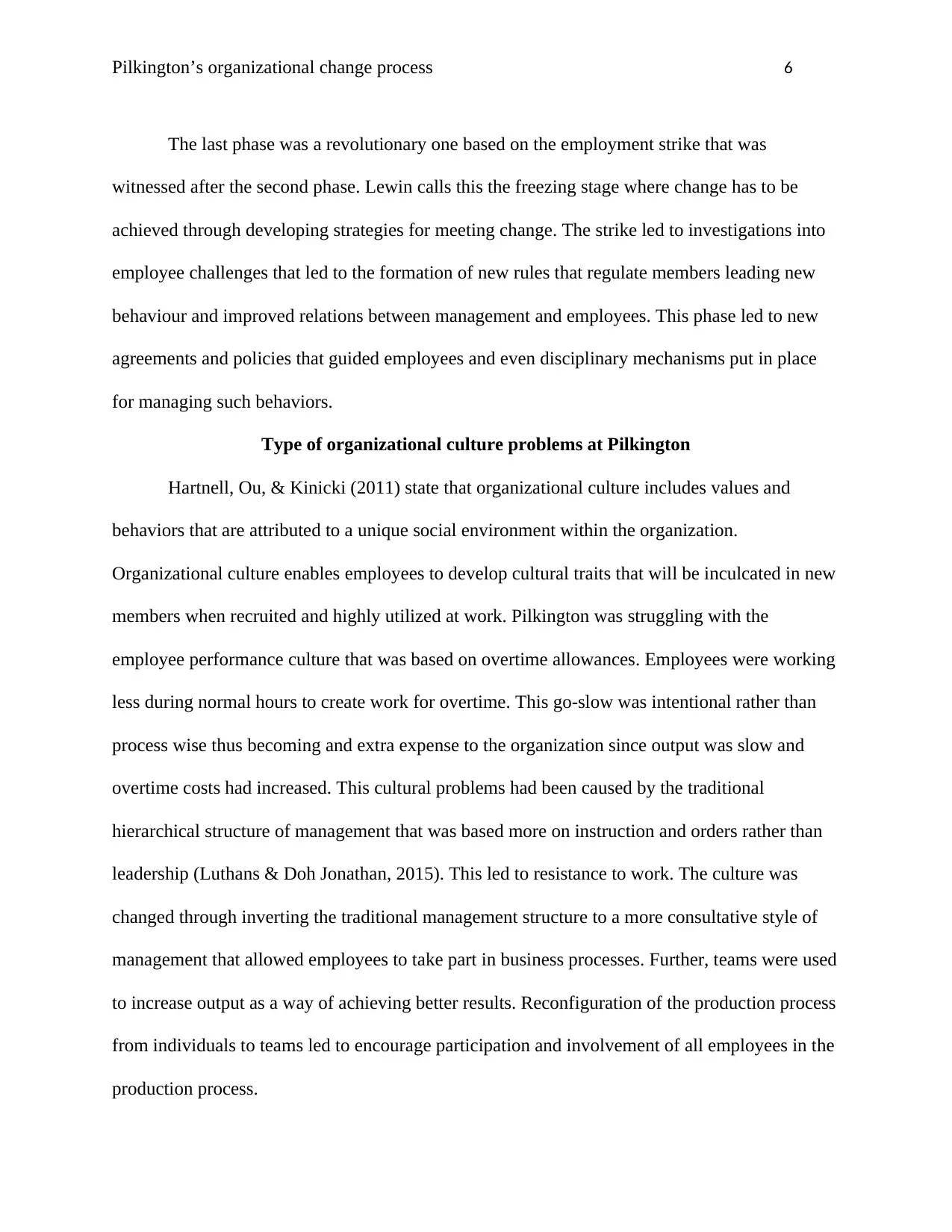
Pilkington’s organizational change process 6
The last phase was a revolutionary one based on the employment strike that was
witnessed after the second phase. Lewin calls this the freezing stage where change has to be
achieved through developing strategies for meeting change. The strike led to investigations into
employee challenges that led to the formation of new rules that regulate members leading new
behaviour and improved relations between management and employees. This phase led to new
agreements and policies that guided employees and even disciplinary mechanisms put in place
for managing such behaviors.
Type of organizational culture problems at Pilkington
Hartnell, Ou, & Kinicki (2011) state that organizational culture includes values and
behaviors that are attributed to a unique social environment within the organization.
Organizational culture enables employees to develop cultural traits that will be inculcated in new
members when recruited and highly utilized at work. Pilkington was struggling with the
employee performance culture that was based on overtime allowances. Employees were working
less during normal hours to create work for overtime. This go-slow was intentional rather than
process wise thus becoming and extra expense to the organization since output was slow and
overtime costs had increased. This cultural problems had been caused by the traditional
hierarchical structure of management that was based more on instruction and orders rather than
leadership (Luthans & Doh Jonathan, 2015). This led to resistance to work. The culture was
changed through inverting the traditional management structure to a more consultative style of
management that allowed employees to take part in business processes. Further, teams were used
to increase output as a way of achieving better results. Reconfiguration of the production process
from individuals to teams led to encourage participation and involvement of all employees in the
production process.
The last phase was a revolutionary one based on the employment strike that was
witnessed after the second phase. Lewin calls this the freezing stage where change has to be
achieved through developing strategies for meeting change. The strike led to investigations into
employee challenges that led to the formation of new rules that regulate members leading new
behaviour and improved relations between management and employees. This phase led to new
agreements and policies that guided employees and even disciplinary mechanisms put in place
for managing such behaviors.
Type of organizational culture problems at Pilkington
Hartnell, Ou, & Kinicki (2011) state that organizational culture includes values and
behaviors that are attributed to a unique social environment within the organization.
Organizational culture enables employees to develop cultural traits that will be inculcated in new
members when recruited and highly utilized at work. Pilkington was struggling with the
employee performance culture that was based on overtime allowances. Employees were working
less during normal hours to create work for overtime. This go-slow was intentional rather than
process wise thus becoming and extra expense to the organization since output was slow and
overtime costs had increased. This cultural problems had been caused by the traditional
hierarchical structure of management that was based more on instruction and orders rather than
leadership (Luthans & Doh Jonathan, 2015). This led to resistance to work. The culture was
changed through inverting the traditional management structure to a more consultative style of
management that allowed employees to take part in business processes. Further, teams were used
to increase output as a way of achieving better results. Reconfiguration of the production process
from individuals to teams led to encourage participation and involvement of all employees in the
production process.
⊘ This is a preview!⊘
Do you want full access?
Subscribe today to unlock all pages.

Trusted by 1+ million students worldwide
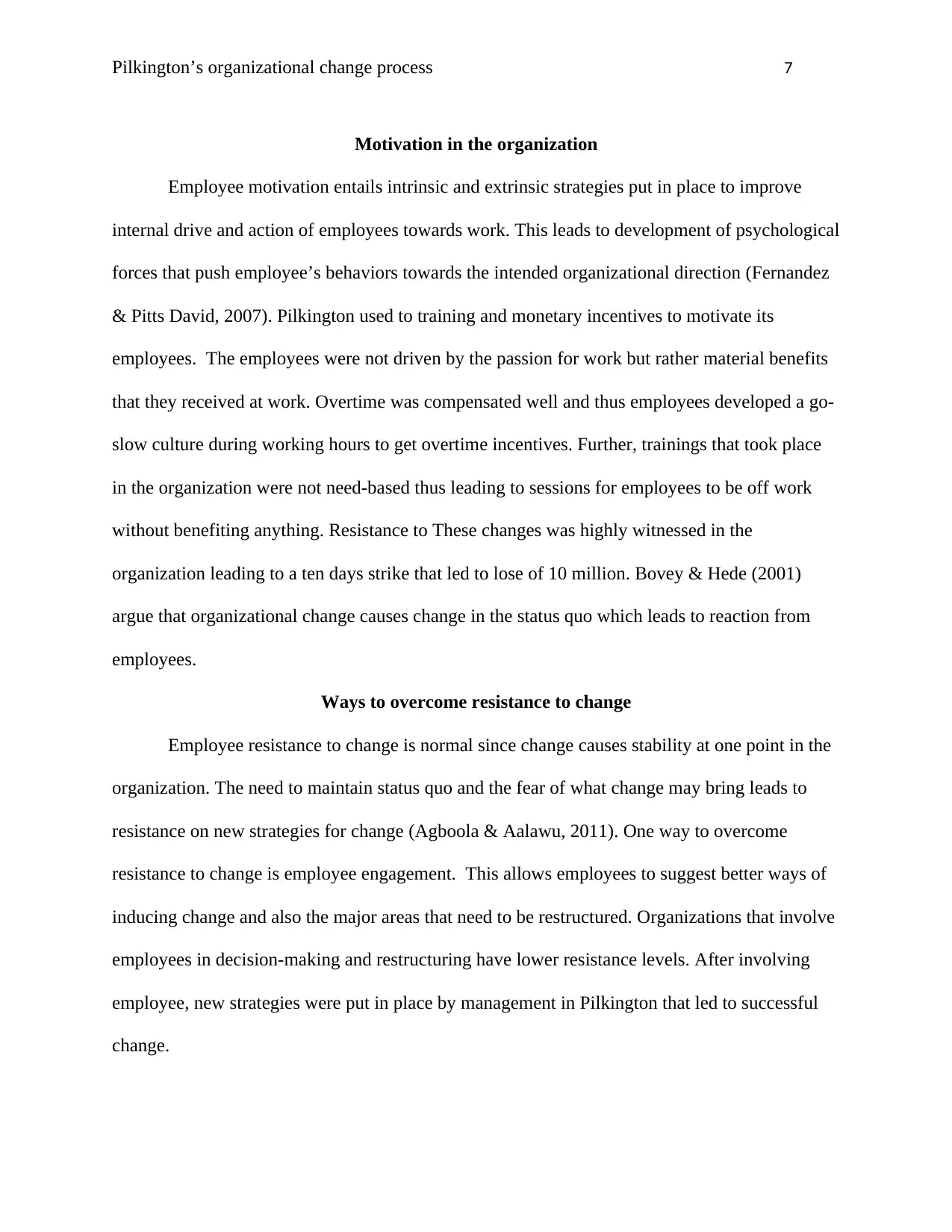
Pilkington’s organizational change process 7
Motivation in the organization
Employee motivation entails intrinsic and extrinsic strategies put in place to improve
internal drive and action of employees towards work. This leads to development of psychological
forces that push employee’s behaviors towards the intended organizational direction (Fernandez
& Pitts David, 2007). Pilkington used to training and monetary incentives to motivate its
employees. The employees were not driven by the passion for work but rather material benefits
that they received at work. Overtime was compensated well and thus employees developed a go-
slow culture during working hours to get overtime incentives. Further, trainings that took place
in the organization were not need-based thus leading to sessions for employees to be off work
without benefiting anything. Resistance to These changes was highly witnessed in the
organization leading to a ten days strike that led to lose of 10 million. Bovey & Hede (2001)
argue that organizational change causes change in the status quo which leads to reaction from
employees.
Ways to overcome resistance to change
Employee resistance to change is normal since change causes stability at one point in the
organization. The need to maintain status quo and the fear of what change may bring leads to
resistance on new strategies for change (Agboola & Aalawu, 2011). One way to overcome
resistance to change is employee engagement. This allows employees to suggest better ways of
inducing change and also the major areas that need to be restructured. Organizations that involve
employees in decision-making and restructuring have lower resistance levels. After involving
employee, new strategies were put in place by management in Pilkington that led to successful
change.
Motivation in the organization
Employee motivation entails intrinsic and extrinsic strategies put in place to improve
internal drive and action of employees towards work. This leads to development of psychological
forces that push employee’s behaviors towards the intended organizational direction (Fernandez
& Pitts David, 2007). Pilkington used to training and monetary incentives to motivate its
employees. The employees were not driven by the passion for work but rather material benefits
that they received at work. Overtime was compensated well and thus employees developed a go-
slow culture during working hours to get overtime incentives. Further, trainings that took place
in the organization were not need-based thus leading to sessions for employees to be off work
without benefiting anything. Resistance to These changes was highly witnessed in the
organization leading to a ten days strike that led to lose of 10 million. Bovey & Hede (2001)
argue that organizational change causes change in the status quo which leads to reaction from
employees.
Ways to overcome resistance to change
Employee resistance to change is normal since change causes stability at one point in the
organization. The need to maintain status quo and the fear of what change may bring leads to
resistance on new strategies for change (Agboola & Aalawu, 2011). One way to overcome
resistance to change is employee engagement. This allows employees to suggest better ways of
inducing change and also the major areas that need to be restructured. Organizations that involve
employees in decision-making and restructuring have lower resistance levels. After involving
employee, new strategies were put in place by management in Pilkington that led to successful
change.
Paraphrase This Document
Need a fresh take? Get an instant paraphrase of this document with our AI Paraphraser
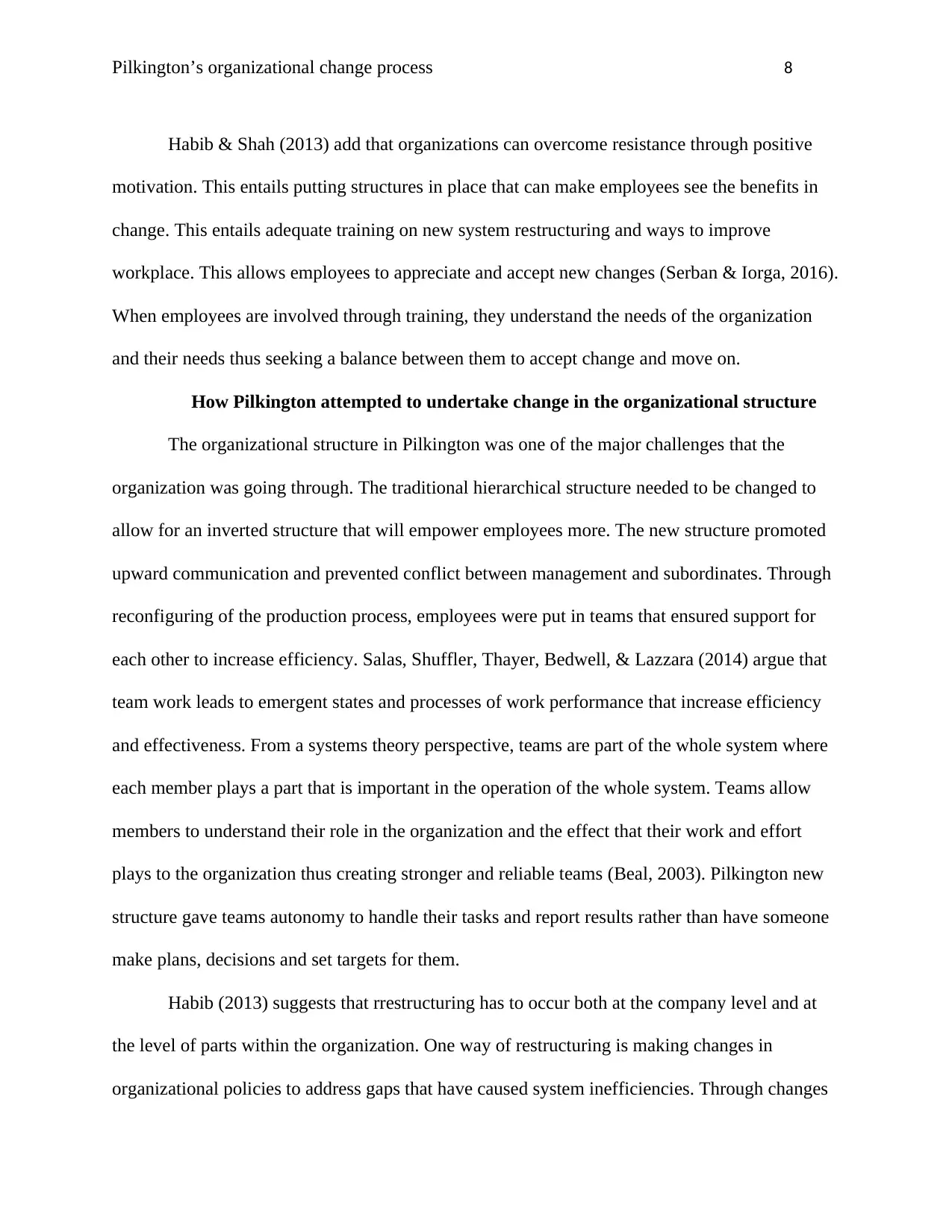
Pilkington’s organizational change process 8
Habib & Shah (2013) add that organizations can overcome resistance through positive
motivation. This entails putting structures in place that can make employees see the benefits in
change. This entails adequate training on new system restructuring and ways to improve
workplace. This allows employees to appreciate and accept new changes (Serban & Iorga, 2016).
When employees are involved through training, they understand the needs of the organization
and their needs thus seeking a balance between them to accept change and move on.
How Pilkington attempted to undertake change in the organizational structure
The organizational structure in Pilkington was one of the major challenges that the
organization was going through. The traditional hierarchical structure needed to be changed to
allow for an inverted structure that will empower employees more. The new structure promoted
upward communication and prevented conflict between management and subordinates. Through
reconfiguring of the production process, employees were put in teams that ensured support for
each other to increase efficiency. Salas, Shuffler, Thayer, Bedwell, & Lazzara (2014) argue that
team work leads to emergent states and processes of work performance that increase efficiency
and effectiveness. From a systems theory perspective, teams are part of the whole system where
each member plays a part that is important in the operation of the whole system. Teams allow
members to understand their role in the organization and the effect that their work and effort
plays to the organization thus creating stronger and reliable teams (Beal, 2003). Pilkington new
structure gave teams autonomy to handle their tasks and report results rather than have someone
make plans, decisions and set targets for them.
Habib (2013) suggests that rrestructuring has to occur both at the company level and at
the level of parts within the organization. One way of restructuring is making changes in
organizational policies to address gaps that have caused system inefficiencies. Through changes
Habib & Shah (2013) add that organizations can overcome resistance through positive
motivation. This entails putting structures in place that can make employees see the benefits in
change. This entails adequate training on new system restructuring and ways to improve
workplace. This allows employees to appreciate and accept new changes (Serban & Iorga, 2016).
When employees are involved through training, they understand the needs of the organization
and their needs thus seeking a balance between them to accept change and move on.
How Pilkington attempted to undertake change in the organizational structure
The organizational structure in Pilkington was one of the major challenges that the
organization was going through. The traditional hierarchical structure needed to be changed to
allow for an inverted structure that will empower employees more. The new structure promoted
upward communication and prevented conflict between management and subordinates. Through
reconfiguring of the production process, employees were put in teams that ensured support for
each other to increase efficiency. Salas, Shuffler, Thayer, Bedwell, & Lazzara (2014) argue that
team work leads to emergent states and processes of work performance that increase efficiency
and effectiveness. From a systems theory perspective, teams are part of the whole system where
each member plays a part that is important in the operation of the whole system. Teams allow
members to understand their role in the organization and the effect that their work and effort
plays to the organization thus creating stronger and reliable teams (Beal, 2003). Pilkington new
structure gave teams autonomy to handle their tasks and report results rather than have someone
make plans, decisions and set targets for them.
Habib (2013) suggests that rrestructuring has to occur both at the company level and at
the level of parts within the organization. One way of restructuring is making changes in
organizational policies to address gaps that have caused system inefficiencies. Through changes
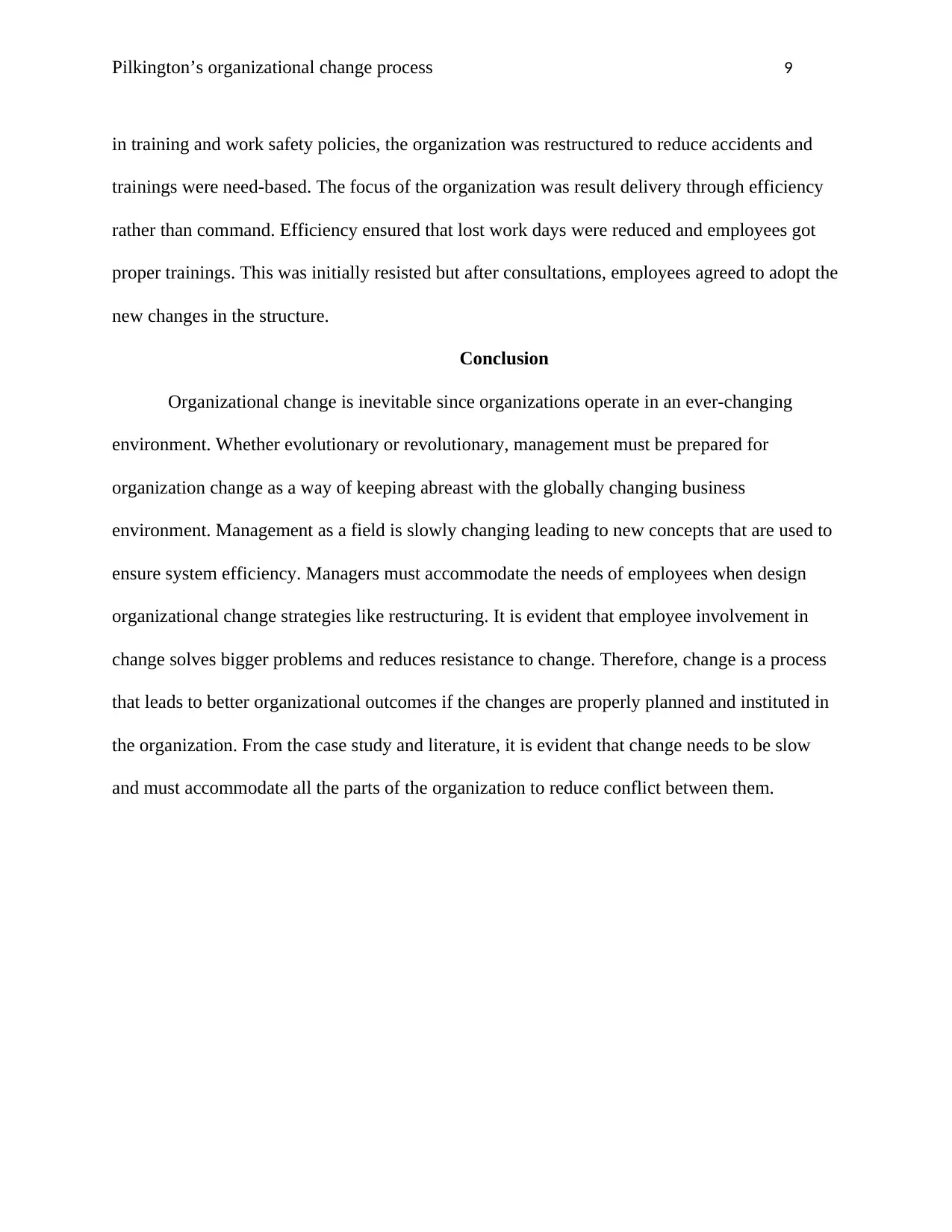
Pilkington’s organizational change process 9
in training and work safety policies, the organization was restructured to reduce accidents and
trainings were need-based. The focus of the organization was result delivery through efficiency
rather than command. Efficiency ensured that lost work days were reduced and employees got
proper trainings. This was initially resisted but after consultations, employees agreed to adopt the
new changes in the structure.
Conclusion
Organizational change is inevitable since organizations operate in an ever-changing
environment. Whether evolutionary or revolutionary, management must be prepared for
organization change as a way of keeping abreast with the globally changing business
environment. Management as a field is slowly changing leading to new concepts that are used to
ensure system efficiency. Managers must accommodate the needs of employees when design
organizational change strategies like restructuring. It is evident that employee involvement in
change solves bigger problems and reduces resistance to change. Therefore, change is a process
that leads to better organizational outcomes if the changes are properly planned and instituted in
the organization. From the case study and literature, it is evident that change needs to be slow
and must accommodate all the parts of the organization to reduce conflict between them.
in training and work safety policies, the organization was restructured to reduce accidents and
trainings were need-based. The focus of the organization was result delivery through efficiency
rather than command. Efficiency ensured that lost work days were reduced and employees got
proper trainings. This was initially resisted but after consultations, employees agreed to adopt the
new changes in the structure.
Conclusion
Organizational change is inevitable since organizations operate in an ever-changing
environment. Whether evolutionary or revolutionary, management must be prepared for
organization change as a way of keeping abreast with the globally changing business
environment. Management as a field is slowly changing leading to new concepts that are used to
ensure system efficiency. Managers must accommodate the needs of employees when design
organizational change strategies like restructuring. It is evident that employee involvement in
change solves bigger problems and reduces resistance to change. Therefore, change is a process
that leads to better organizational outcomes if the changes are properly planned and instituted in
the organization. From the case study and literature, it is evident that change needs to be slow
and must accommodate all the parts of the organization to reduce conflict between them.
⊘ This is a preview!⊘
Do you want full access?
Subscribe today to unlock all pages.

Trusted by 1+ million students worldwide
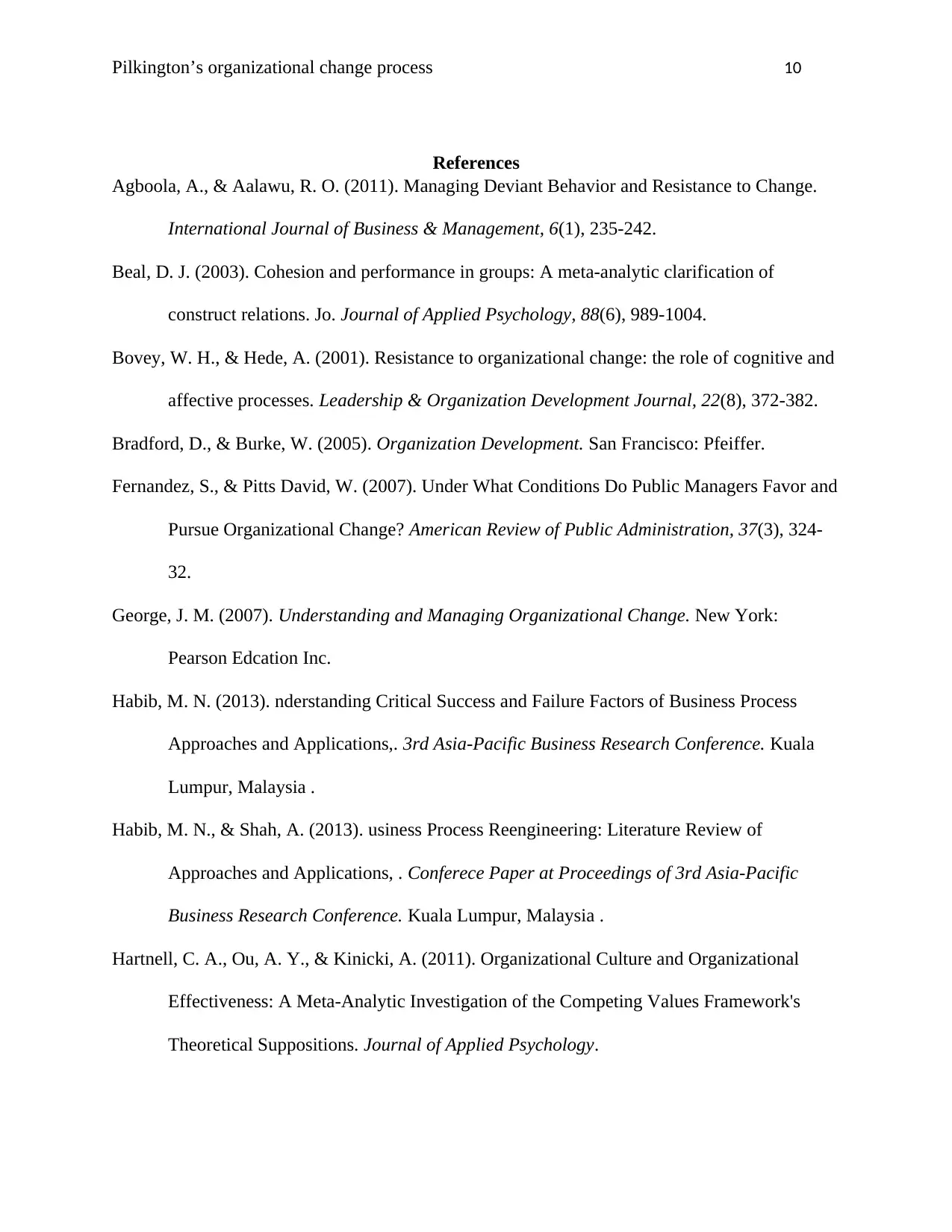
Pilkington’s organizational change process 10
References
Agboola, A., & Aalawu, R. O. (2011). Managing Deviant Behavior and Resistance to Change.
International Journal of Business & Management, 6(1), 235-242.
Beal, D. J. (2003). Cohesion and performance in groups: A meta-analytic clarification of
construct relations. Jo. Journal of Applied Psychology, 88(6), 989-1004.
Bovey, W. H., & Hede, A. (2001). Resistance to organizational change: the role of cognitive and
affective processes. Leadership & Organization Development Journal, 22(8), 372-382.
Bradford, D., & Burke, W. (2005). Organization Development. San Francisco: Pfeiffer.
Fernandez, S., & Pitts David, W. (2007). Under What Conditions Do Public Managers Favor and
Pursue Organizational Change? American Review of Public Administration, 37(3), 324-
32.
George, J. M. (2007). Understanding and Managing Organizational Change. New York:
Pearson Edcation Inc.
Habib, M. N. (2013). nderstanding Critical Success and Failure Factors of Business Process
Approaches and Applications,. 3rd Asia-Pacific Business Research Conference. Kuala
Lumpur, Malaysia .
Habib, M. N., & Shah, A. (2013). usiness Process Reengineering: Literature Review of
Approaches and Applications, . Conferece Paper at Proceedings of 3rd Asia-Pacific
Business Research Conference. Kuala Lumpur, Malaysia .
Hartnell, C. A., Ou, A. Y., & Kinicki, A. (2011). Organizational Culture and Organizational
Effectiveness: A Meta-Analytic Investigation of the Competing Values Framework's
Theoretical Suppositions. Journal of Applied Psychology.
References
Agboola, A., & Aalawu, R. O. (2011). Managing Deviant Behavior and Resistance to Change.
International Journal of Business & Management, 6(1), 235-242.
Beal, D. J. (2003). Cohesion and performance in groups: A meta-analytic clarification of
construct relations. Jo. Journal of Applied Psychology, 88(6), 989-1004.
Bovey, W. H., & Hede, A. (2001). Resistance to organizational change: the role of cognitive and
affective processes. Leadership & Organization Development Journal, 22(8), 372-382.
Bradford, D., & Burke, W. (2005). Organization Development. San Francisco: Pfeiffer.
Fernandez, S., & Pitts David, W. (2007). Under What Conditions Do Public Managers Favor and
Pursue Organizational Change? American Review of Public Administration, 37(3), 324-
32.
George, J. M. (2007). Understanding and Managing Organizational Change. New York:
Pearson Edcation Inc.
Habib, M. N. (2013). nderstanding Critical Success and Failure Factors of Business Process
Approaches and Applications,. 3rd Asia-Pacific Business Research Conference. Kuala
Lumpur, Malaysia .
Habib, M. N., & Shah, A. (2013). usiness Process Reengineering: Literature Review of
Approaches and Applications, . Conferece Paper at Proceedings of 3rd Asia-Pacific
Business Research Conference. Kuala Lumpur, Malaysia .
Hartnell, C. A., Ou, A. Y., & Kinicki, A. (2011). Organizational Culture and Organizational
Effectiveness: A Meta-Analytic Investigation of the Competing Values Framework's
Theoretical Suppositions. Journal of Applied Psychology.
Paraphrase This Document
Need a fresh take? Get an instant paraphrase of this document with our AI Paraphraser
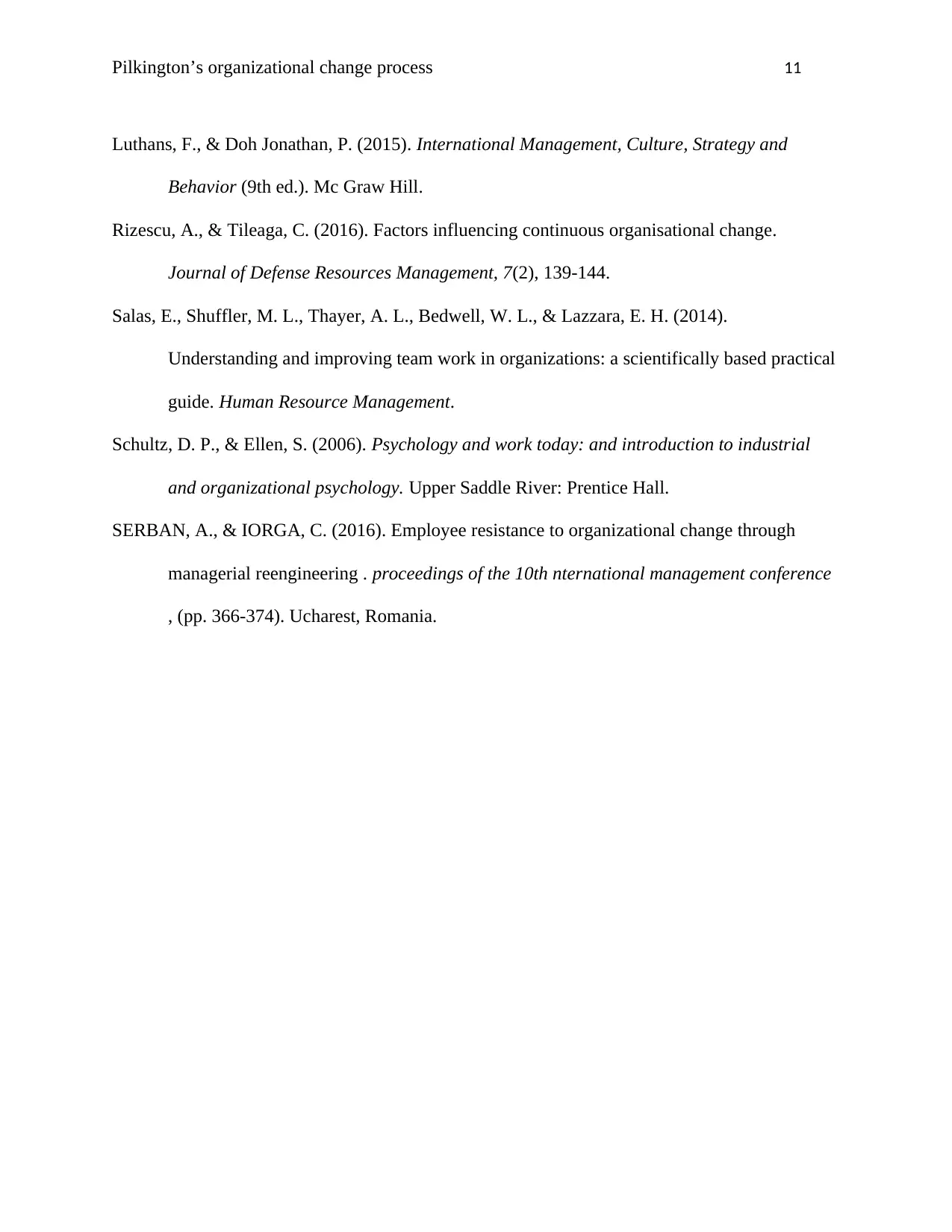
Pilkington’s organizational change process 11
Luthans, F., & Doh Jonathan, P. (2015). International Management, Culture, Strategy and
Behavior (9th ed.). Mc Graw Hill.
Rizescu, A., & Tileaga, C. (2016). Factors influencing continuous organisational change.
Journal of Defense Resources Management, 7(2), 139-144.
Salas, E., Shuffler, M. L., Thayer, A. L., Bedwell, W. L., & Lazzara, E. H. (2014).
Understanding and improving team work in organizations: a scientifically based practical
guide. Human Resource Management.
Schultz, D. P., & Ellen, S. (2006). Psychology and work today: and introduction to industrial
and organizational psychology. Upper Saddle River: Prentice Hall.
SERBAN, A., & IORGA, C. (2016). Employee resistance to organizational change through
managerial reengineering . proceedings of the 10th nternational management conference
, (pp. 366-374). Ucharest, Romania.
Luthans, F., & Doh Jonathan, P. (2015). International Management, Culture, Strategy and
Behavior (9th ed.). Mc Graw Hill.
Rizescu, A., & Tileaga, C. (2016). Factors influencing continuous organisational change.
Journal of Defense Resources Management, 7(2), 139-144.
Salas, E., Shuffler, M. L., Thayer, A. L., Bedwell, W. L., & Lazzara, E. H. (2014).
Understanding and improving team work in organizations: a scientifically based practical
guide. Human Resource Management.
Schultz, D. P., & Ellen, S. (2006). Psychology and work today: and introduction to industrial
and organizational psychology. Upper Saddle River: Prentice Hall.
SERBAN, A., & IORGA, C. (2016). Employee resistance to organizational change through
managerial reengineering . proceedings of the 10th nternational management conference
, (pp. 366-374). Ucharest, Romania.
1 out of 11
Related Documents
Your All-in-One AI-Powered Toolkit for Academic Success.
+13062052269
info@desklib.com
Available 24*7 on WhatsApp / Email
![[object Object]](/_next/static/media/star-bottom.7253800d.svg)
Unlock your academic potential
Copyright © 2020–2025 A2Z Services. All Rights Reserved. Developed and managed by ZUCOL.





